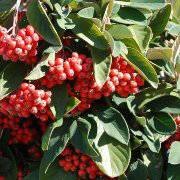Our Ultimate Guide To Cotoneaster Hedge Plants
The name Cotoneaster stems from the Latin ’cotone’ for quince and ‘aster’ for resembling because of its similarity to the plant Quince. It is a relative of the Hawthorn hedging family and is native to the Palaearctic region.
Cotoneaster is a popular type of hedging that offers various advantages and benefits to your garden. These include the beautiful combination of seasonal flowers and berries, as well as evergreen foliage. If you're looking for a hedge plant that can fully decorate your landscape area with colour while attracting local wildlife, we recommend Cotoneaster.
Varieties of Cotoneaster
There are four varieties of Cotoneaster hedging including Cotoneaster franchetii (Franchet's Cotoneaster), Cotoneaster horizontails (Wall Cotoneaster), Cotoneaster lacteus (Late Cotoneaster) and Cotoneaster simonsii (Himalayan Cotoneaster). The different varieties of Cotoneaster available and each species have something appealing. Each Cotoneaster is different in appearance, particularly when during their prime season or variations in their foliage, meaning each variety is popular for different reasons. Cotoneasters provide both formal and informal hedging. The weeping branches of lacteus provide a fantastic informal hedge, and franchetii is ideal for a formal hedge. The year-round interest and combination of flowers and berries have ensured that all four varieties remain popular.
Cotoneaster Horizontalis

If you're after a hedge for wall and fence coverage, then choose Cotoneaster horizontails (Wall Cotoneaster). It's the perfect hedge plant and has a fantastic architectural structure. Cotoneaster horizontails produces striking red berries in autumn with the small green leaves turning a stunning red/orange, and white flowers with a hint of pink in spring.
Cotoneaster Lacteus

Cotoneaster lacteus (Late Cotoneaster) produces evergreen foliage and possesses stunning weeping branches to create a beautiful casual effect. This species of Cotoneaster provides year-round interest, producing beautiful white flowers in summer and red berries which carry on into the winter, as well as dark evergreen foliage.
Cotoneaster Franchetii

Cotoneaster franchetti (Franchet's Cotoneaster) is a beautiful evergreen hedge plant with arching branches covered with small, oval leaves. A colourful and productive hedge, Cotoneaster Franchetti will develop attractive white flowers and bright orange berries, as well as its evergreen grey-green foliage.
Cotoneaster Simonsii

If you're looking for a semi-evergreen plant, Cotoneaster simonsii (Himalayan Cotoneaster) is an excellent option. It has an upright habit and produces beautiful white flowers in summer, along with large scarlet berries and dark green foliage. Cotoneaster simonsii provides excitement, livening up your garden during autumn when their leaves become tinted with red.
Cotoneaster Hedge Height, Growth and Pruning
Each Cotoneaster species have different ideal hedge heights. Franchetti, lacteus and horizontails are the perfect choices if you're looking to grow a hedge between 1m-2m tall. All three types will typically grow at around 20-40cm per annual. Cotoneaster franchetti and lacteus hedge plants only require a light trim once a year, after the berries have fallen, whereas Cotoneaster horizontalis requires pruning in late winter or early spring. Cotoneaster simonsii will be at its best at heights between 1-1.5m and grows at around 20-40cm per year. February is the recommended time to trim your Cotoneaster simonsii hedge to shape and if required, prune any unruly growth after flowering.
Evergreen Cotoneaster Hedging Varieties
Cotoneaster hedging is a combination of deciduous and evergreen. We have two types of evergreen Cotoneaster hedging available: franchetti and lacteus. As evergreen hedging, they are incredibly popular, as they maintain their colour all year-round, offering constant and attractive cover. Cotoneaster franchetti and lacteus are beneficial to local wildlife. They ensure there is a year-round home for birds and small animals to live in our gardens. The flowers and berries are seasonal, so you can expect some change throughout the year, knowing that foliage will remain bright and colourful.
Cotoneaster simonsii can be considered semi-evergeen as in mild winters it can sometimes keep its leaves.
Cotoneaster and Wildlife
Cotoneaster is the prefect hedge plant if you enjoy and want to attract more wildlife to your garden. The natural flowers and berries that occur across the different varieties of Cotoneaster provide food for the birds. The berries produced also provide food for birds and other small animals. At the same time, the flowers offer a brilliant source of nectar for the different bees that may arrive in your garden, including honey bees and bumblebees. Cotoneaster also attracts certain varieties of butterflies.
For more information about Cotoneaster hedging, speak to one of Hedges Direct's expert team on 01257 494 139 or email us at [email protected]
 Hedges Direct
Hedges Direct 



